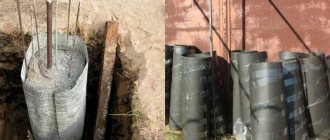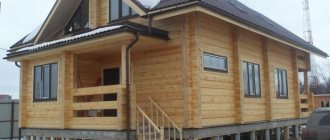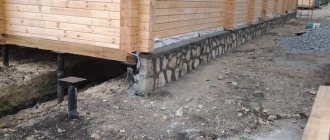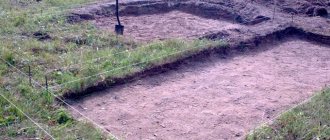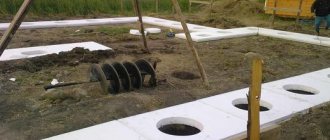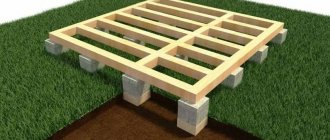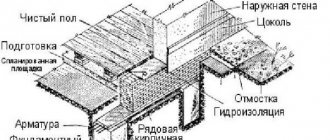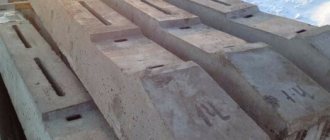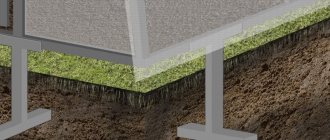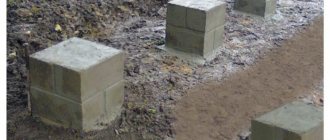It’s always nice to have your own bathhouse near a private house or on a summer cottage. Building a bathhouse can be quite expensive. But if you have a small budget, this does not mean that you need to deny yourself the pleasure of visiting the bathhouse. Many people build a frame bathhouse or from timber; this design is quite inexpensive and light, so there is no need to spend money on a complex and expensive foundation; you can make a regular columnar foundation.
Bathhouse on a columnar foundation: structure and design features
A columnar foundation is a structure consisting of pillars located along the perimeter of the future building. They are located in the corners of the building, at points where internal partitions pass, and in places with significant load. Typically, the pillars are placed at a distance of 1.5-2 m. The exact value depends on the material from which the bathhouse will be built. The heavier it is, the smaller the distance between the pillars.
To make the structure more reliable and rigid, individual pillars are connected with grillages, which in the future will also be useful for installing the base.
Columnar foundation for a bathhouse. Video:
Foundation Features
Let's start with the good - the most obvious advantage of a columnar foundation is its low cost compared to other types. Fewer materials are used, and you can do without large construction equipment and hiring assistants. The price of a columnar foundation for a bathhouse will undoubtedly please budget-conscious owners and allow them to spend money on high-quality furniture or interior decoration.
Even a novice craftsman without experience in such work can handle the construction of foundation pillars. To do this, you just need to know how to mix concrete, dig holes and use a level. The performance qualities of the building do not suffer at all. Moreover, in some cases it is preferable to build buildings only on poles, for example, if the site is located on heaving, moving soil.
A columnar foundation consists of several pillars arranged in rows. Each pillar falls on one of the key points of the future structure - at the intersection of walls and special loads. The optimal distance between the pillars is from 1.5 to 2.3 m and directly depends on the loads on the base (the material from which the bathhouse will be built). To make the foundation more stable, grillages are used - strong support beams that connect the pillars to each other, accept and distribute the load. If the distance between the pillars is more than 2.5 m, the grillages are replaced with rand beams - more powerful connecting elements.
The depth of laying the foundation pillars depends on the type of soil. On sandy soil with deep groundwater, a shallow foundation can be made. On clay soil that is prone to heaving, the pillars need to be buried deeper than the soil freezing level so that they do not warp in the spring. The columnar foundation is considered quite versatile, since it can be built for almost any need and on any soil. Often, such a foundation allows you to easily build a house in difficult landscapes where there is no way to level the soil. The foundation does not need large-scale insulation work - it is enough to protect it from moisture and insulate the floor of the bathhouse. The only drawback is that you can’t have a basement in a bathhouse on a columnar foundation, and if you think about it, it’s not really needed there.
Things to consider before starting construction:
- the weight of the future building should be small (a three-story brick house is not the best option for a columnar foundation);
- the cost of constructing a columnar foundation will be 1.5-2 times less than that of a strip foundation, and even more so a monolithic one;
- this type of base is least susceptible to heaving due to the small area of the pillars in contact with the shingle;
- It is better to abandon a columnar foundation if the height difference under it is more than 2 m;
- It is also not recommended to build it on weak soils, otherwise the pillars may simply tilt and topple. The same rule applies to soils with low bearing capacity (clayey, watery, peaty).
Considering that most bathhouses are made of wooden beams, and this is a fairly light structure, then a columnar foundation is quite suitable for it, even if we are talking about heaving soils. In this case, experts recommend not to deepen the base, since heaving forces will act on the pillars with all their might. A moderately deep or shallow foundation will be much more stable. To do this, the pillars need to be immersed in the ground by 40-50 cm, and the laying depth should be in the range of values from 1/3 to ½ of the calculated freezing depth, which is 50-70% less than the freezing depth. For example, if the soil freezes to a depth of 1 m, then the pillars need to be buried at 50-70 cm.
Columnar foundation for a bathhouse: advantages
- possibility of installation on difficult terrain, for example, in hilly areas;
- inexpensive cost, which helps reduce the price of the entire bath;
- quick installation. The construction of a columnar foundation is quite simple, it can even be done in one day;
- ease of installation. Even a master without experience in this field can handle the construction of a columnar foundation. You just need to know how to mix concrete and use a level;
- Possibility of installation on unstable soils, as well as on soil with a large freezing depth. The strip foundation must be installed below the soil freezing level, but when this indicator is too high, the cost of the foundation increases significantly. In this case, it makes more sense to make a columnar foundation;
- the drawdown is lower than that of a strip foundation.
Brick and stone columnar foundation
The construction of a foundation for a bathhouse, based on brick and stone, involves the implementation of construction activities similar to the construction of a foundation using blocks.
Brick foundation pillars can only be built from red clay baked bricks
In this case, you should pay attention to the fulfillment of technological requirements:
- the feasibility of increasing the volume of the hole in the ground for the convenience of carrying out work on brick or stone masonry;
- the need to strengthen the concrete base of the pit with a wire mesh made of steel reinforcement with a cross-section of 1.2 cm;
- the use of only solid bricks on a ceramic base, which have the required strength and resistance to low temperatures;
- installation of reinforcing mesh to increase the strength of columns every four rows of masonry.
The main disadvantage is the presence of seams, which gradually lead to the destruction of the support.
Columnar foundation and its types
According to the manufacturing method, there are two types of columnar foundations: monolithic and columnar.
A monolithic foundation is a single and seamless structure made of reinforced concrete; its technology resembles a strip foundation. A monolithic foundation has increased strength, but its installation is more complex, since formwork and reinforcement need to be done.
The columnar foundation has separate supports. This option is more popular because it is much cheaper and is also easy to install. It may also include the presence of a grillage, i.e., a special strapping that makes the structure stronger.
Depending on the type of supports, there are also several types of foundations:
- wood;
- brick;
- concrete;
- rubble concrete;
- reinforced concrete;
- blocky.
Wooden foundations are rarely made, since this material has the least strength. If you still decide to use it, then treat the material with an antiseptic and provide it with reliable waterproofing.
The most popular options are concrete and brick. Such designs are reliable and durable. They are also a great option if you are planning to do the foundation yourself. Foundations made of concrete and brick have a long service life, they are reliable and durable.
We recommend reading:
Warm floors in the bathhouse: types and features. How to make heated floors in a bathhouse?
Depending on the depth, a columnar foundation can be:
- buried;
- shallow.
When constructing a buried foundation, the supports are located 0.5-1 m below the soil freezing level. The foundation is built on clay soil, where there is a lot of water.
A shallow foundation is made at a depth of 0.4-0.7 m. It is usually installed on rocky, sandy and heaving soils. The main feature of this type of foundation is that the pouring depth should be approximately 20-30% less than the freezing level of the soil.
What is a columnar foundation?
A wooden columnar foundation is used for small baths, but is not particularly durable.
These are free-standing pillars whose task is to serve as supports for the walls. This base is suitable only for relatively light structures - frame or wooden. The main disadvantage of this type is the impossibility of arranging a basement or cellar. But this minus is more than compensated by its high efficiency and reliability. In addition, no additional waterproofing work will be required.
The construction of a columnar foundation involves the use of brick, rubble stone, reinforced concrete and rubble concrete . As for the type of brick, it is better not to use red slotted or silicate. By the way, if your bathhouse is small and light, then you can simply place it on wooden poles, but, however, it is better not to count on the durability of such a support.
- columnar foundation made of blocks;
- columnar foundation made of pipes;
- columnar foundation with grillage.
How to make a columnar foundation for a bathhouse
Stage 1. Preparation
There are several types of columnar foundations; before choosing the appropriate option, you need to carefully study the soil. To determine the groundwater level, you need to dig a small hole in diameter about 1 m deep. If there is no groundwater at this level, and the soil itself is not heaving (without clay), then this depth will be quite enough for the pillars. Otherwise, you need to dig further, and the pillars must be placed at the level of freezing depth, increased by 0.4 m.
Afterwards, you need to prepare the territory itself: clear it of debris, trees, and bushes. To remove grass cover, it is best to cut off the top layer of soil (about 30 cm).
The area should be as level as possible, so all holes should be filled with sand or gravel, and the hillocks should be leveled.
Stage 2. Marking
Next, based on the design of the bathhouse, you need to decide where the foundation will be located. For marking you will need pegs and rope. The pegs need to be inserted into the ground in the corners of the future building, and then connected with a cord.
Check the evenness of the corners with a square, and also measure the diagonals. The difference in their length should not exceed a few centimeters, otherwise the marking will need to be done again.
Don't neglect this step! Make sure the markings are as even as possible. If the foundation turns out to be crooked, then the entire bathhouse will also be uneven! And this will lead to a decrease in its service life.
Stage 3. Preparing the pits
Pits should be made in the corners of rooms, under load-bearing walls, and also along the perimeter at a distance of 1.5-2 m. To prepare holes, you can use a cone-shaped drill or an escalator. If you don't have one, no worries, you can make holes by hand using a shovel.
The depth of the pits should be 0.2-0.3 m greater than the planned depth of the foundation, since sand backfill will need to be made.
The width is taken to be approximately 0.1 m larger than the width of the supports, so that you can easily insert the reinforcement cage.
At the bottom of each hole you need to make a sand cushion: fill it with a layer of sand about 0.2 m, add a little water to it, compact it.
Stage 4. Installation of pillars
As already mentioned, different materials can be used for columns; the installation of each of them has its own characteristics.
Columnar foundation for a brick bath
This is the best option for people with little construction experience. On top of the sand cushion you need to pour a concrete base, reinforced with reinforcement. To do this, you need to use reinforcement with a diameter of 12-14 mm.
You need to leave the concrete for a few days to dry, and then you can start laying bricks. Solid ceramic bricks are suitable for the foundation.
We recommend reading:
Strip foundation and its features. How to make a strip foundation for a bathhouse? Step-by-step instruction
The service life of the foundation can vary, it depends on the quality of the brick and masonry, climatic conditions, on average it is 50-100 years.
The bricks must be laid in a strictly vertical column; it is recommended to use cement mortar for masonry. Check each laid out “floor” with a level, this will help make the post as even as possible.
To increase the reliability of the foundation, make a reinforcing mesh every 3-4 rows.
Afterwards, the brick must be covered with a waterproofing material (roofing felt with hot bitumen or mastic).
Leave to dry, and after a week, cover the pillars with earth and compact them thoroughly.
Columnar foundation for a bathhouse made of blocks
To install this type of foundation, you need to use concrete blocks measuring 20x20x40 cm. They are laid similarly to bricks, but still have several differences.
Since concrete blocks are heavier, it is better to make the sand cushion thicker, not 0.2-0.3 m, but 0.5-0.7 m.
Next, you need to lay two blocks side by side. The next row also consists of two blocks, but they must be placed perpendicular to the previous ones. Then repeat in the same way until the pillars are 0.2-0.3 m above ground level.
To protect the seams and blocks from moisture and temperature changes, they must be covered with waterproofing material.
The gaps around the blocks must be filled with earth and compacted.
Columnar foundation for a pipe bath
To build this type of foundation, pipes with a diameter of at least 20 cm are needed; they can be metal or asbestos-cement. To protect pipes from moisture, they need to be wrapped in roofing felt with bitumen, treated with mastic or covered with waterproofing material.
The pipes must be lowered into the pits strictly vertically, the pillars must be 0.4 m above the ground level. The gaps on the outside of the pipes must be filled with earth and compacted.
To strengthen the foundation you need to make reinforcement. To do this, reinforcing bars are stuck into the pipes, which should be higher than the pipes themselves. Afterwards, concrete is poured into them step by step.
First you need to pour it into about 1/3 of the pipe, then lift the pipe a little so that it is distributed along the bottom.
Then fill the pipe with concrete to approximately 0.2-0.3 m in height and compact it with a vibropress. Repeat the procedure until the pipe is full.
Leave for 1-1.5 weeks for the concrete to dry.
Columnar foundation made of pipes
Pipes made of metal or asbestos cement with a diameter of 20 cm are considered the best option for constructing a columnar foundation. They are easy to cut into pieces of the required length. Such a column should protrude 40 cm above the surface.
To protect pipes from destruction due to moisture, they should be treated with special waterproofing mastics or wrapped with rolled materials, for example, roofing felt with bitumen.
The finished supports are lowered into the recesses as evenly as possible.
In the spaces between the posts and the edges of the hole, fill in the soil that was previously removed from the hole, or sand and gravel that needs to be compacted. The thickness of this layer is 40-50 cm. Next, several reinforcement rods with a cross-section of 12-14 mm are inserted inside each column, 7 cm from each other. Their length should exceed the height of the pillars by 20%.
Now you should fill the columns with concrete solution. It is optimal to use M400 cement, sand, small or medium crushed stone. To prepare concrete with your own hands, you should use a ratio of 1: 1.5: 3. Add 400 g of water per kilogram of cement. Concrete must be poured in several approaches.
After pouring the concrete, the columns are covered with film and left to dry and gain strength for 7-10 days. After this period, you can begin work on the construction of the bathhouse.
This technique is quite popular because it can significantly save time and money, and can also be done independently.

